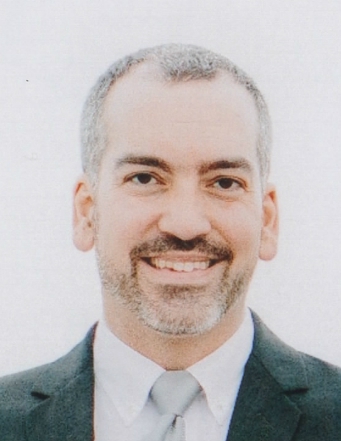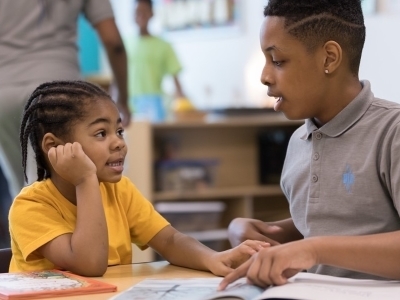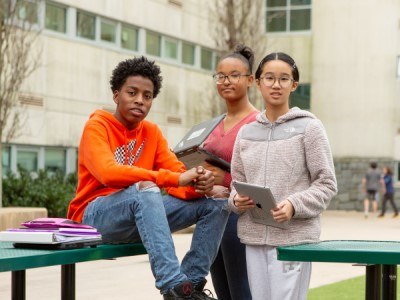Listening to Student Voices: The Sound of Assessment for Learning
Topics
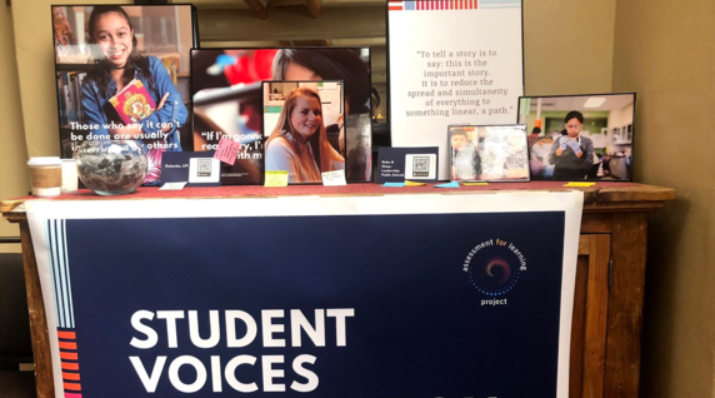
Educators are rethinking the purposes, forms, and nature of assessment. Beyond testing mastery of traditional content knowledge—an essential task, but not nearly sufficient—educators are designing assessment for learning as an integral part of the learning process.
Practitioner's Guide to Next Gen Learning
What would it look like if student voice truly shaped the design of public education systems? Reflections culled from the Assessment for Learning Project (ALP) community offer some helpful insights.
What would it look like if student voice truly shaped the design of public education systems?
I posed this reflection prompt to the Assessment for Learning Project (ALP) community in December 2017, as part of their preparation for the annual convening in April 2018. This edition of Friday Focus: Practitioner’s Guide to Next Gen Learning tells the story of what came out of that reflection, including:
- A multi-media installation of student voices, talking about how they experience assessment...and how they would like to experience it
- Rich conversations around the potential of assessment for learning
- Rethinking many fundamental school practices
- Imagining new roles for students in learning design and education policy
In April, we gathered for our annual ALP convening. The meeting space, a typical hotel conference room, was transformed by an installation of photographs, quotes, and student voices we had collectively created over the previous four months. The faces and voices of these students surrounded us for the next two days as we discussed how assessment for learning could become the norm in public education.
Excerpts from student interviews were posted on the walls as part of the installation, but the magic happened when we pointed our phone cameras at the QR code next to each student portrait. Scanning this code brought up an audio clip of that student talking about his or her learning. When we invited our 100 guests to move from their table discussions to the installation, the room fell silent as every adult plugged in their headphones and listened to student voices.
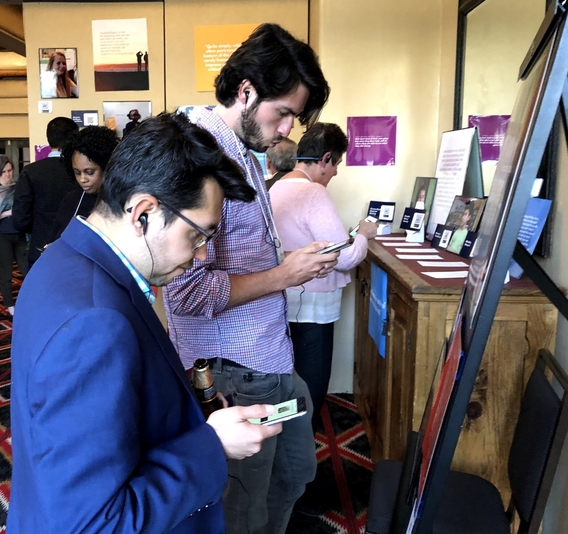
Formative Assessment, Peer Feedback, Self-Assessment
When you’re giving someone feedback, you’re not just doing it to get it over with. You’re doing it to help somebody.
—An elementary student in WestEd’s Student Agency in Assessment & Learning project
I would rather use the [self assessment] tool than the teacher looking over it, because the teacher would think, “oh, she’s not good at this, we’re gonna do something else.” It’s better to look at your own work, because you can make your own opinions about yourself.
—Tamara, speaking about the National Writing Project’s Student-facing Using Sources Tool
Listening to young people explain how self assessment and feedback helps them move their learning forward, how might we rethink grading policies and practice to prioritize rich, actionable feedback? This kind of feedback (including the reflective processes involved in self assessment and peer feedback) is the heart of formative assessment. Might we invest in formative feedback as much (or more) as we have invested in data-driven instruction?
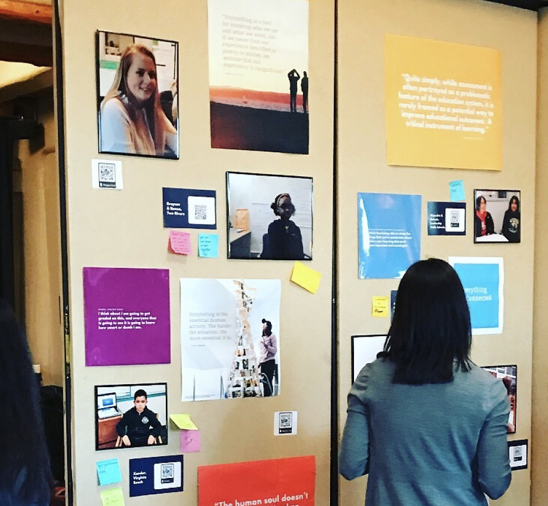
Learning Progressions
When you say assessment, I think of tests. Because most assessments are tests, and we always take tests. A learning progression shows me where I should be with how I’m doing things, where I should be with my writing. It shows you how to better yourself on your writing, or really in any class. It just shows you how to get from one level to another level....On a test, you’re just answering questions and it doesn’t show you where you should be. On a learning progression, it shows you where you should be and how you can get higher from that, and go to the next level. I think kids learn best when they have something to look at to show where their expectations stand, and to know just how to move forward, and not just being stuck on one thing and not knowing how to go on from it.
—Cassie, high school student in Colorado
I would take the examples in the learning progression and fit them to my writing. It helped me fix my mistakes. I feel like I criticize myself a lot, so I feel like when I go through and I notice that something’s not on there I can improve it. Like in a regular assessment you have your assignment and you get graded, like “here’s a percentage,” where here you’re graded and you can grow off of it. It’s not like you get a five out of ten, it’s like, “you’re here and you can still build off of it.”
—Taylor, high school student in Colorado
I think it helps me learn on the things I’m doing wrong and the mistakes I’m making, so that in the future I can do better on my work, and eventually not make those same mistakes...In other classes you’re not given a learning progression, so I feel like students become more nervous to ask. They don’t want to make a mistake and look stupid.
—Tasia, high school student in Colorado
One of the most powerful parts of the experience for me was listening to students talk about the conclusions they draw about themselves and about learning as a result of different approaches to assessment. These young people understand how assessment can build confidence, rather than undermine it. A learning progression, like those developed by teachers in partnership with the Colorado Education Initiative, is one way to accomplish this because it represents learning as a developmental continuum—an ongoing process of moving from novice to more complex understanding.
As the students make clear, this helps shift the conversation from a fixed perception of their capabilities (“here’s what I got wrong on the test”) to a growth orientation (“here’s where I’m going and how I can get there”). If we think about each student traveling along a continuum of learning, how might we reconsider some of the fundamental organizing principles of school, such as age-based cohorts, and the age-based standardized tests that lock students into them?
Capstone Project
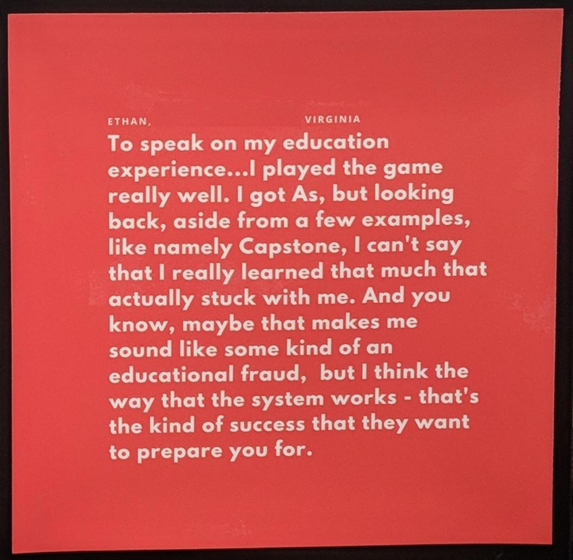
My capstone was on the effect of positive student-teacher relationships in a high school community. This capstone really, really got me invested in school, that I got to really pour what I care about into, and how important it is for a teacher and student to be connected, because it was a teacher who got me to be more connected in school.
—Elizabeth, a high school student in Virginia speaking of her Capstone project
I think it’s really important to be able to choose something you’re passionate about, because then it’s really more than just like learning and writing a paper and then you turn it in, and the next day you’re done with it. It’s something that really stays with me, because I’m passionate about it. I’m not just doing it to do the paper, I’m doing it to actually learn.
—Beth, a high school student in New Hampshire speaking about her junior project
As a parent, these are exactly the kinds of things I want to hear my own children saying about their learning. That they are exploring their passions and discovering new possibilities for who they can become. That they are invested in their learning, and they’re applying what they know to issues they believe are important. This is how the students in the Voices of ALP installation describe their interdisciplinary, student-designed capstone projects.
Standardized tests play some important roles in public education, but inspiring passion and deepening investment are not among these roles. Standardized tests aren’t going anywhere, but if we want all of our children to be passionate and invested in their learning, how might we rethink graduation requirements to include student-driven projects? How might capstone projects and portfolios be incorporated into college admissions?
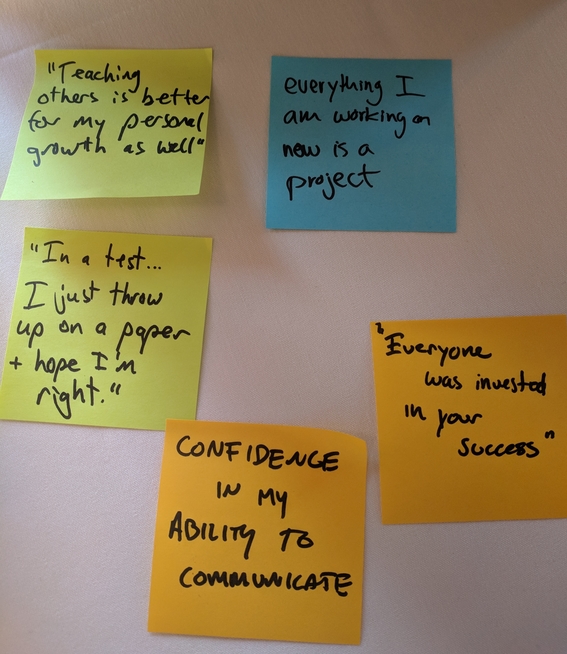
What would it look like if student voice truly shaped the design of public education systems? The voices of these students raise profound questions about the designs of our schools and systems. How might we—the adults who design and influence schools and systems—listen to student voices in ways that can more deeply shape public education? There is a long tradition of educators who have passionately and creatively brought student voice into policy. We believe that the student voices installation methodology we developed makes a new and important contribution to this tradition.
The installation is an example of collective storytelling. Each ALP grantee partner became an interviewer, listening intently to students reflect on their learning. Working with our storytelling partner Gather & Create, we turned hours of recordings into about 50 one-minute clips, making it feasible for participants to hear most or all of the voices. Though we couldn’t fly those 50 students to the meeting, we found a way to bring their voices. By creating an installation, we allowed our community to engage with the voices in personal, intimate ways while also making sense collaboratively of the stories these voices were telling.
The Assessment for Learning community includes teachers and school leaders, senior policy makers, researchers, district and charter network administrators, and professional learning providers. Like every other education group, we are susceptible to buzzwords, we face competing incentives, and we work in dramatically diverse contexts. To create the education systems our children deserve, we must of course draw on research, respect the craft and expertise of educators, and operate within the messy democratic structures for educational decision making. But without some common language, we will not reach shared goals for our kids.
With the student voices installation, we asked, what if our common language emerged not from white papers, symposia, and “thought leaders”? What if our shared language and vision emerged from something entirely different: the sound of learning, in the voices of learners themselves?
And now we ask, how will YOU listen to the voices of your students, and how might this shape the design of your schools and systems?
Resources
This Voices of ALP Toolkit provides the rationale, along with instructions and tips, for creating and experiencing your own “Voices of…” installation.
Listen to the students, policy-makers and pundits, a blog post by Grant Wiggins that features the voices of five teens on the power of teachers to make a difference in students’ lives.
Why is Student Voice Important in Education? In this Students at the Center video resource by the Nellie Mae Education Foundation, students discuss the importance of including their voices in all aspects of education to make it more personal, relevant, and engaging.
Giving Students a Voice, from the Harvard Graduate School of Education, offers five ways to welcome student input and bolster your school's success.

